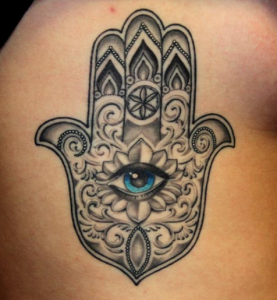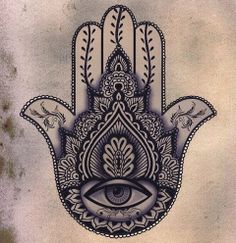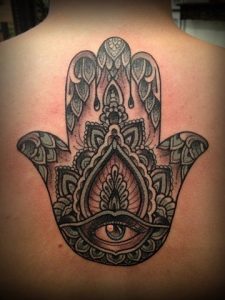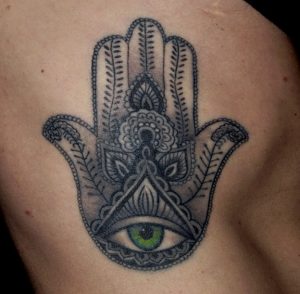Hamsa Tattoos – Meaning and Ideas
In Hebrew and Arabic languages Hamsa means ‘five’. This symbolizes the five fingers on a hand and the five senses that humans have. The Hamsa symbol is a beautiful artistic rendering of a hand which often encompasses an eye in it’s palm or other symbols which represent protection. These days a lot of people have permanent Hamsa Tattoos decorated for individual wards of protection and also as a symbol of good luck. It can also known as the hand of Fatima, the hand of Mary or the hand of Miriam depending on the religion.
If the fingers are open it represents power and protection and when the fingers are closed this is a ward of good luck. The direction that the hand is positioned alters the meaning, pointing upwards is a ward against the evil eye and facing downwards represents the hand of god.
The Hamsa is believed to have originated in Greece and Rome where it was a symbol of protection, bravery and good luck. The Hamsa has its roots entwined deep within many cultures and religions.


The Hamsa In Christianity
The Hamsa appears in the Christian religion and is believed to represent the hand of the Virgin Mary. In this instance it applies power, strength and femininity and is often incorporates the fish symbol which represents Christ.
The Hamsa In Judaism
The Hamsa depicts the presence of god in all things within creation and is often referred to as the Hand of Moses Eldest sister Miriam. Many also believe that it may depict the five books of the Torah.
The Hamsa In Islam
Hamsa is also known as Khamsa, which is an Arabic word that means ‘five’. The five fingers represent the five pillars of Islam; Shahadah, Salat, Zakat, Sawm and Hajj. Some also refers to the Hamsa as the hand of Muhammad’s daughter Fatima.
In general the basic design of the Hamsa is used for the good of ones self or that of others which are important to the wearer. No matter what the religious background many who have the Hamsa tattoo see it as a symbol of security and protection from evil bringing the wearer many good boons such as fortune, good luck and health. Though this theory is not held by all as other traditions see the Hamsa when incorporating an eye as evil as used in some ancient civilisations to do harm unto others.


Variations in Hamsa Tattoos
A Hamsa tattoo can incorporate other signs and symbols. The additions are added to customise the meaning or protection for the individual. Common additions include the star, which centers in the palm with its spikes extending to the edges of the hand. The star represents existence and new life. A vine is often used to entwine the hand meaning bonding or joining of two spirits. A heart is used when the individual wishes to make a bond of Love, passion and lust. Where a six settled flower would bring the wearer balance and peace within their life. In ancient Egypt when the Hamsa symbol is applied with the eye, it will symbolise protection. This eye is called the eye of Horus, an Egyptian god of the sky. The Eye of Horus is an ancient Egyptian symbol of protection, royal power and good health.
Hamsa tattoos are predominately black and gray, but can also be fully or partly coloured. Some people get their loved ones names near the tattoo in order to evoke the protection for them. Black and Gray Hamsa tattoos often have very detailed line-work and are stunning to look at.
The Hamsa symbol is a very beautiful tattoo for women of any faith that can help them feel connected with their feminity while also being protected as the symbol is widely used across so many religions and cultures.
The shoulder, back, and the back of neck are the most common placements for Hamsa tattoos as this location has a very protection oriented vibe.







